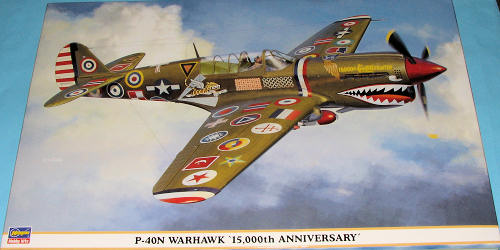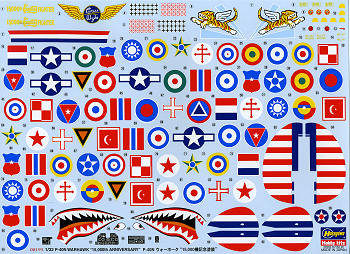
Hasegawa 1/32 P-4N Warhawk '15,000th Anniversary'
| KIT #: | 08195 |
| PRICE: | $74.50 SRP |
| DECALS: | One option |
| REVIEWER: | Scott Van Aken |
| NOTES: | Limited reissue |

| HISTORY |
The P-40's lack of a two-stage supercharger made it inferior to Luftwaffe fighters such as the Messerschmitt Bf 109 or the Focke-Wulf Fw 190 in high-altitude combat and it was rarely used in operations in Northwest Europe. Between 1941 and 1944, however, the P-40 played a critical role with Allied air forces in three major theaters: North Africa, the Southwest Pacific and China. It also had a significant role in the Middle East, Southeast Asia, Eastern Europe, Alaska and Italy. The P-40's high-altitude performance was not as critical in those theaters, where it served as an air supremacy fighter, bomber escort and fighter bomber.
P-40s first saw combat with the British Commonwealth squadrons of the Desert Air Force (DAF) in the Middle East and North African campaigns, during June 1941.The Royal Air Force's No. 112 Squadron was among the first to operate Tomahawks, in North Africa, and the unit was the first to feature the "shark mouth" logo, copying similar markings on some Luftwaffe Messerschmitt Bf 110 twin-engine fighters. The logo was made famous by the P-40s of the Flying Tigers in China.
In theatres where high-altitude performance was less important, the P-40 proved an effective fighter. Although it gained a post-war reputation as a mediocre design, suitable only for close air support, more recent research including scrutiny of the records of individual Allied squadrons indicates that the P-40 performed surprisingly well as an air superiority fighter, at times suffering severe losses, but also taking a very heavy toll on enemy aircraft. The P-40 offered the additional advantage of low cost, which kept it in production as a ground attack fighter long after it was obsolete in air superiority.
The P-40N, and subject of this kit (manufactured 1943-44), was the final production model. The P-40N featured a stretched rear fuselage to counter the torque of the larger, late-war Allison engine, and the rear deck of the cockpit behind the pilot was cut down at a moderate slant to improve rearward visibility. A great deal of work was also done to try and eliminate excess weight to improve the Warhawk's climb rate. Early N production blocks dropped a .50 in (12.7 mm) gun from each wing, bringing the total back to four; later production blocks reintroduced it after complaints from units in the field. Supplied to Commonwealth air forces as the Kittyhawk Mk IV. A total of 553 P-40Ns were acquired by the Royal Australian Air Force, making it the variant most commonly used by the RAAF. Subvariants of the P-40N ranged widely in specialization from stripped down four-gun "hot rods" which could reach the highest top speeds of any production variant of the P-40 (up to 380 mph), to overweight types with all the extras intended for fighter-bombing or even training missions.
As of 2008, 19 P-40s remain airworthy.
| THE KIT |
 Hasegawa
made a smart decision when it decided to produce the later P-40s in 1/32 scale.
It allowed them at least four major variants by only changing a tail insert and
if they want to do the Merlin versions, then that adds at least two more. It
should keep them in Limited Edition reissues for decades.
Hasegawa
made a smart decision when it decided to produce the later P-40s in 1/32 scale.
It allowed them at least four major variants by only changing a tail insert and
if they want to do the Merlin versions, then that adds at least two more. It
should keep them in Limited Edition reissues for decades.
As you can see from the parts layout, Hasegawa's P-40 kit has a considerable number of inserts. This latest one provides a longer rear fuselage section with a different clear section to allow the N model to be produced. It is one of the later, six gun versions, though thanks to inserts, an early one could easily be provided.
The kit has a very nicely done cockpit that will satisfy the
majority of modelers. Instruments are raised detail or you can use the provided
decals; your choice. A nice wing spar is part of the wheel well assembly and fits into the one piece lower wing. The tail section is a separate assembly
and while it is shown being completely built up before attachment, many modelers
like to join each tail half to the forward fuselage before gluing the fuselage
halves together. I've done both on various kits and it seems either way
provides about the same results. You have the option of either a drop tank or a
bomb. For this kit, the bomb is painted red, white, and blue. Hasegawa is also
nice enough to provide a full pilot figure for those who like having occupied
cockpits. The use the correct one.
and fits into the one piece lower wing. The tail section is a separate assembly
and while it is shown being completely built up before attachment, many modelers
like to join each tail half to the forward fuselage before gluing the fuselage
halves together. I've done both on various kits and it seems either way
provides about the same results. You have the option of either a drop tank or a
bomb. For this kit, the bomb is painted red, white, and blue. Hasegawa is also
nice enough to provide a full pilot figure for those who like having occupied
cockpits. The use the correct one.
Instructions are pretty well an industry standard and superbly done. The lone markings option is a huge sheet for the most pimped-out fighter of WWII, the Curtiss plane used to celebrate the 15,000th Curtiss fighter. Even the wing tip markings are provided. it would be a shame to use an aftermarket decal sheet for this one. Decals are superbly printed and the instructions provide an exact placement guide for all of them.
| CONCLUSIONS |
So there you have it. A great 1/32 scale Warhawk and a very impressive decal sheet to accompany it. I'm not sure how well these markings sell, but they sure are going to make a conversation piece! As a short note, the two places where I go to check on retail prices have sold out already.
| REFERENCES |
http://en.wikipedia.org/wiki/P-40N
September 2009
My thanks to www.dragonmodelsusa.com
for the preview kit. Get yours today at your local shop or on-line retailer.
Thanks If you would like your product reviewed fairly and quickly, please
contact
me or see other details in the
Note to
Contributors.